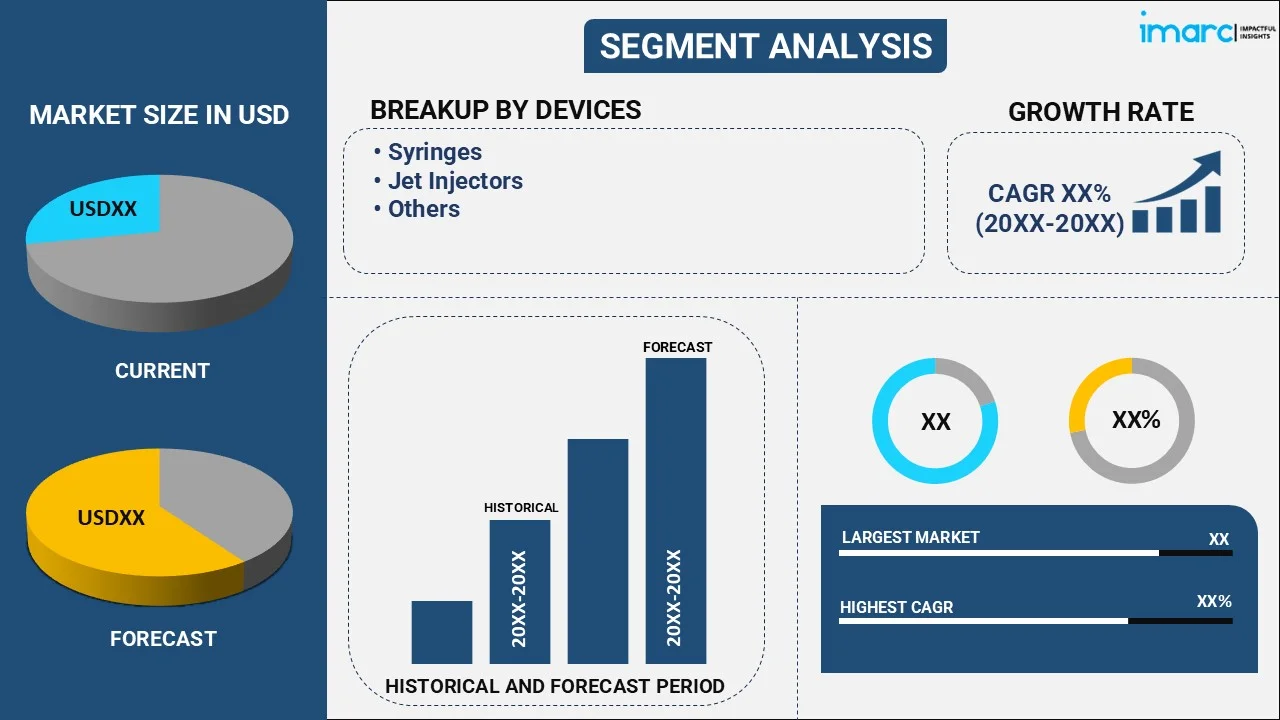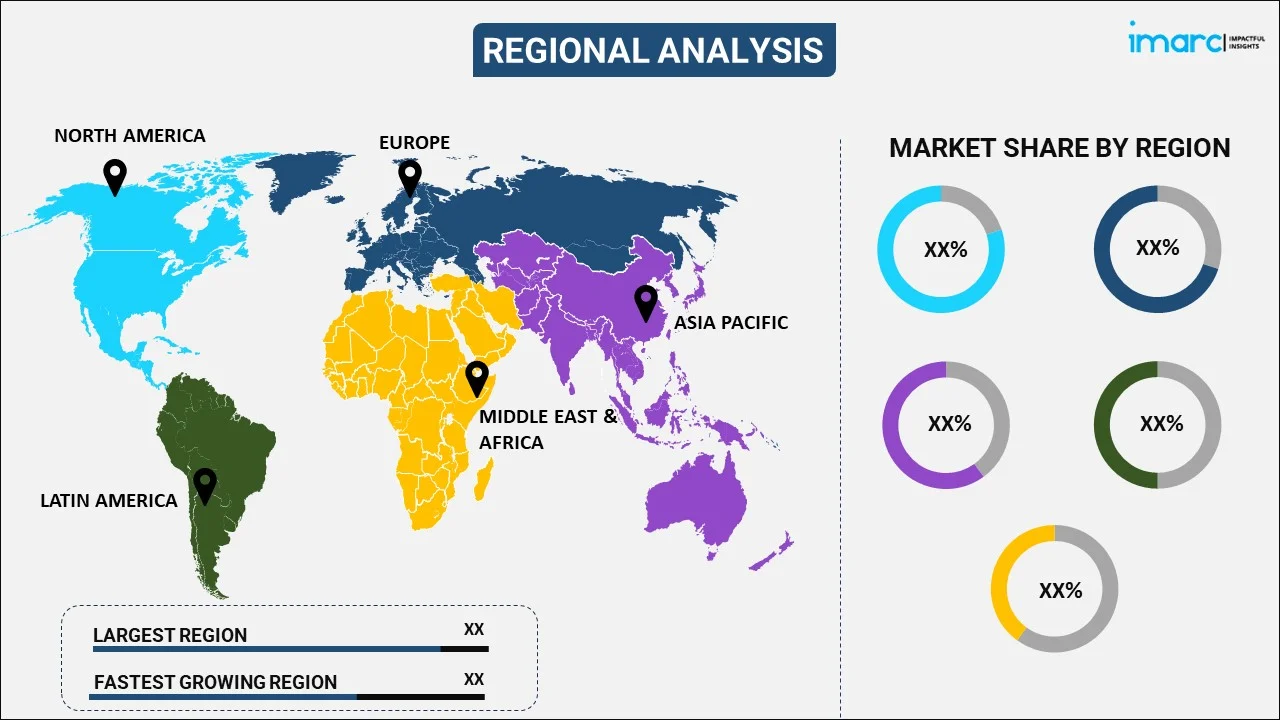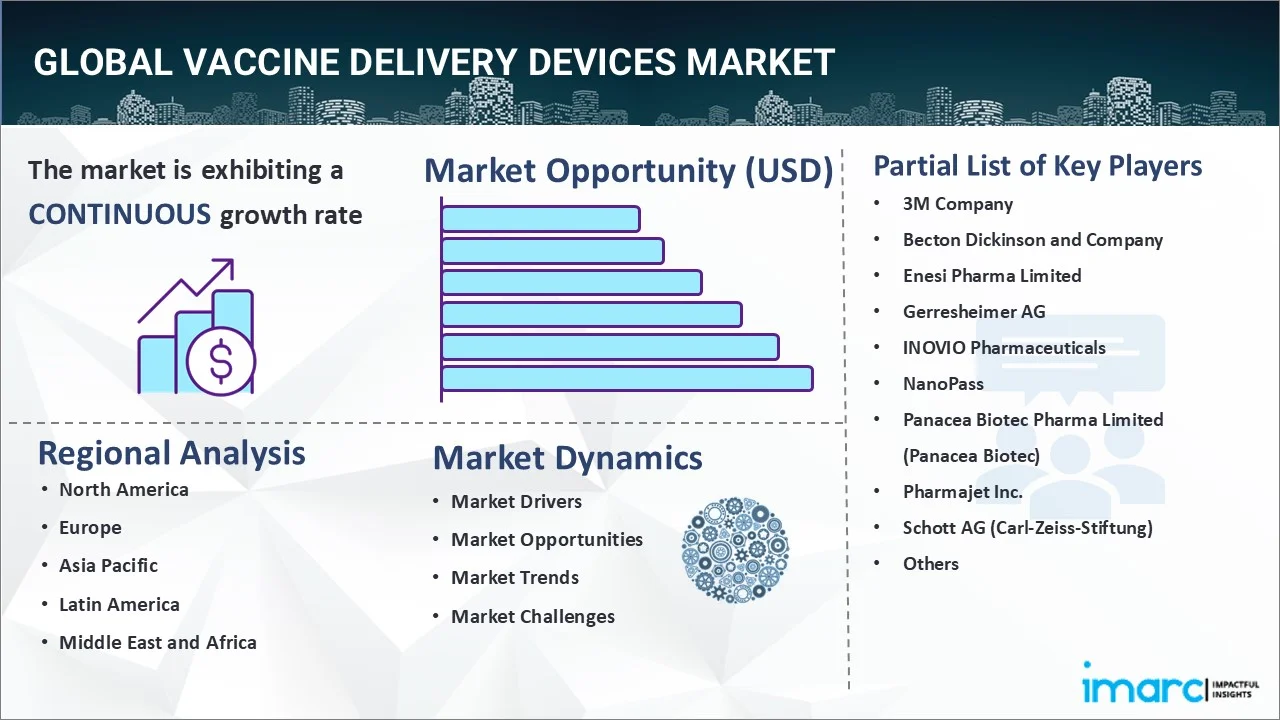
Vaccine Delivery Devices Market Report by Device (Syringes, Jet Injectors, and Others), Route of Administration (Intramuscular Vaccination, Intradermal Vaccination, Subcutaneous Vaccination, and Others), End User (Hospitals, Clinics, Others), and Region 2025-2033
Vaccine Delivery Devices Market Size:
The global vaccine delivery devices market size reached USD 8.0 Billion in 2024. Looking forward, IMARC Group expects the market to reach USD 14.3 Billion by 2033, exhibiting a growth rate (CAGR) of 6.28% during 2025-2033. The market is experiencing steady growth driven by the growing awareness and demand for vaccination, coupled with innovations such as needle-free injectors and microneedles, the rising prevalence of infectious diseases, and ongoing strategic collaborations among key players.
|
Report Attribute
|
Key Statistics
|
|---|---|
|
Base Year
|
2024
|
|
Forecast Years
|
2025-2033
|
|
Historical Years
|
2019-2024
|
|
Market Size in 2024
|
USD 8.0 Billion |
|
Market Forecast in 2033
|
USD 14.3 Billion |
| Market Growth Rate (2025-2033) | 6.28% |
Vaccine Delivery Devices Market Analysis:
- Major Market Drivers: The escalating prevalence of infectious diseases and growing emphasis on vaccination programs are the major factors driving the vaccine delivery devices market. Besides this, the technological upgradation of delivery methods, such as microneedles and needle-free injectors are also favoring the market.
- Key Market Trends: There is an increasing trend towards minimally invasive or painless delivery methods, with large investments in the R&D of novel devices. One of the other vaccine delivery devices market trends being witnessed is that numerous new and upcoming companies are focusing on creating smart delivery systems that can monitor and adjust the superfluous dosage in real-time.
- Geographical Trends: North America and Europe dominate the market due to advanced healthcare infrastructure and a high rate of vaccination coverage. Asia-Pacific shows high growth due to increased healthcare expenditure and government initiatives in emerging markets.
- Competitive Landscape: The market is moderately competitive; key players in the industry are focusing on strategic collaborations, mergers, and acquisitions to widen their current product portfolios. The major companies in this market are heavily investing in innovative delivery technologies.
- Opportunities and Challenges: Major challenges are high regulatory requirements and high costs of advanced delivery devices, which may limit market penetration into developing regions. On the other hand, the vaccine delivery devices market recent opportunities lie in the increasing demand for combination vaccines and rising technologies that can increase both delivery efficiency and patient compliance.
Vaccine Delivery Devices Market Trends:
Increasing prevalence of infectious diseases
The demand for vaccines is escalating due to the growing prevalence of infectious diseases, such as influenza, measles, and COVID-19 in several regions globally. In 2021, approximately 16 billion vaccines worth US$ 141 billion were sold, compared to 5.8 billion doses circulating in the market in 2019, valued at an estimated US$ 38 billion. This growth was mainly driven by COVID-19 vaccines, showing the incredible potential of how vaccine manufacturing can be scaled up in answer to health needs. Therefore, this is positively influencing the vaccine delivery devices market revenue. Along with this, global governments and health bodies are focused on immunization as a preventive method for epidemics and a clamping brake on the spread of such diseases across borders. These proactive approaches increase the exigency for advanced vaccine delivery devices to ensure that vaccines are administered safely and effectively. High awareness about the importance of vaccination and subsequent high coverage of vaccination rate are important parameters propelling the demand for advanced vaccine delivery devices. Apart from this, recurrent outbreaks and the looming threat of pandemics exerting substantial pressure on researchers and developers for innovations in delivery technologies is creating a positive vaccine delivery devices market outlook.
Technological advancements in delivery methods
The advances in novel delivery technologies, such as microneedles, needle-free injectors, and transdermal patches, are changing the vaccine delivery landscape. Such changes have the objective of effectiveness, safety, and compliance. For instance, microneedle patches deliver vaccines painlessly and can even do so without reliance on refrigeration. In addition, the experience for the user is thus made more pleasant with technologies such as these, and free accounts of veto points in their logistics. This was further facilitated by the smart features of the devices used in the actual delivery of vaccines to allow for real-time monitoring and dosage adjustments. The vaccine delivery devices market overview suggests that continuous innovation in this field attracts a lot of investments and leads to a series of collaborations between medical device companies and research institutions.
Government initiatives and immunization programs
The vaccine delivery devices market growth is further driven by government vaccination programs and policies. Most of the developing and developed countries have set up elaborate vaccination programs for their infants, children, and adults, thus creating a demand for vaccines to prevent various infectious diseases. This is supported by vast financial and other resources to ensure the vaccines have gone to the grassroots. In addition, global health agencies such as the World Health Organization and UNICEF significantly facilitate the cause of vaccination and support developing countries' immunization programs. They provide procurement and distribution for both vaccines and their delivery devices, in addition to training health workers in vaccine administration. Recently Africa CDC and UNICEF expanded their partnership, which works on the strengthening of primary health care; supply chain management and pooled procurement; local manufacturing; and emergency response. According to the vaccine delivery devices market report, the consistent focus of public health authorities on vaccination ensures a lot of demand for advanced delivery devices, thereby supporting the steady growth of the market.
Vaccine Delivery Devices Market Segmentation:
IMARC Group provides an analysis of the key trends in each segment of the market, along with forecasts at the global, regional, and country levels for 2025-2033. Our report has categorized the market based on device, route of administration and end user.
Breakup by Device:

- Syringes
- Jet Injectors
- Others
Syringes account for the majority of the market share
The report has provided a detailed breakup and analysis of the market based on the device. This includes syringes, jet injectors, and others. According to the report, syringes represented the largest segment.
Syringes dominate the devices that are used in the delivery of vaccines. The vaccine delivery devices market forecast suggests that they are relatively cheap and can be used to deliver any type of vaccine, making them the most widely and commonly used. Due to their reliability and familiarization with healthcare workers, traditional syringes have indeed played a very significant role in vaccination programs worldwide. Besides, the introduction of safety-engineered syringes, developed specifically to prevent needle-stick injuries and further reduce the risk of infecting oneself, has even advanced their dominance in the market. Their safety profile continued to be improved following the development of auto-disable syringes, as the technology of syringes advanced, further towards presenting the auto-disable syringes, which are designed for one-time use to conform to the single-use rule. This adaptability of these canulae to deliver vaccines with precise dosage and ease in both mass immunization campaigns and routine vaccination has made them important tools against infectious diseases. Ongoing investments concerning manufacturing capacity and other similar improvements to aseptic, ready-to-fill syringe-filling, and finishing capacity have also been put in place in a bid to ensure that the supply meets the increasing vaccine delivery devices demand, especially in situations following the outbreak of pandemics and emerging infectious diseases.
Breakup by Route of Administration:
- Intramuscular Vaccination
- Intradermal Vaccination
- Subcutaneous Vaccination
- Others
Intramuscular Vaccination holds the largest share of the industry
A detailed breakup and analysis of the market based on the route of administration have also been provided in the report. This includes intramuscular vaccination, intradermal vaccination, subcutaneous vaccination, and others. According to the report, intramuscular vaccination accounted for the largest market share.
The segment of intramuscular (IM) vaccination holds the largest vaccine delivery devices market share in the route of administration for the market of vaccine delivery devices. This is majorly due to the wide acceptance of intramuscular vaccination, as it is effective in administering a wide range of vaccines. Vaccination into muscle tissue is relatively preferred, as many vasculatures in this tissue will help enhance the immune response of the antigen. This is completely appropriate with vaccines requiring penetration deeper into the tissue for optimal absorption and, therefore, the efficacy of the antigen, such as influenza, hepatitis, and COVID-19 vaccines. Moreover, ease of administration and means to use longer needles to get to the layer of muscle added to the reliability and standard of IM vaccination in both clinical and mass immunization settings. A continuing preference for the usage of IM injections is also related to their compatibility with the widest range of vaccine formulations, including liquid to lyophilized vaccines. In addition, technological progress in IM injection, including prefilled syringes and auto-injectors, is increasing its precision, safety, and ease, supporting the dominance of this route. According to the vaccine delivery devices market analysis, technological improvement in intramuscular injection, such as prefilled syringes, and autoinjectors, has significantly improved the precision, safety, and ease of this route, thereby supporting the dominance of this route.
Breakup by End User:
- Hospitals
- Clinics
- Others
Hospitals represent the leading market segment
The report has provided a detailed breakup and analysis of the market based on the end user. This includes hospitals, clinics, and others. According to the report, hospitals represented the largest segment.
The largest end-use segment is hospitals in the vaccine delivery devices industry since they involve the real heart of vaccine administration and usually handle huge immunization programs. The key reason for this is that hospitals, being the primary setup of patient care, are abundant in human and material resources and infrastructures for handling the complexities of storage and the subsequent logistics involved in the further handling and administration of the vaccines. They play an extremely important role as points for routine and emergency immunization and preventive healthcare services. At a hospital, a patient gets the assurance of comprehensive care, including the ability to undertake any indicated medical procedure or intervention in the event of any adverse reactions, thus increasing safety and instilling confidence in the vaccination. Hospitals are also regularly checking vaccine delivery devices market recent developments during clinical trials and other research work. In addition, it is much easier to track and manage vaccination scheduling through the EHRs used in hospitals to ensure that there is broad protection for individuals, effective follow-up, and monitoring of immunization. It is, therefore, for this reason that they have the highest capacity for delivery and monitoring of vaccinations, thus being the largest end-use segment for the market for vaccine delivery devices.
Breakup by Region:

- North America
- United States
- Canada
- Asia-Pacific
- China
- Japan
- India
- South Korea
- Australia
- Indonesia
- Others
- Europe
- Germany
- France
- United Kingdom
- Italy
- Spain
- Russia
- Others
- Latin America
- Brazil
- Mexico
- Others
- Middle East and Africa
The report has also provided a comprehensive analysis of all the major regional markets, which include North America (the United States and Canada); Asia-Pacific (China, Japan, India, South Korea, Australia, Indonesia, and others); Europe (Germany, France, the United Kingdom, Italy, Spain, Russia, and others); Latin America (Brazil, Mexico, and others); and the Middle East and Africa.
Competitive Landscape:
The market research report has also provided a comprehensive analysis of the competitive landscape in the market. Detailed profiles of all major companies have also been provided. Some of the major market players in the vaccine delivery devices industry include:
- 3M Company
- Becton Dickinson and Company
- Enesi Pharma Limited
- Gerresheimer AG
- INOVIO Pharmaceuticals
- NanoPass
- Panacea Biotec Pharma Limited (Panacea Biotec)
- Pharmajet Inc.
- Schott AG (Carl-Zeiss-Stiftung)
- Terumo Corporation
- Vaxxas
(Please note that this is only a partial list of the key players, and the complete list is provided in the report.)
Competitive players in the vaccine delivery devices market are focusing on innovation, strategic partnerships, and broadening their product lines. All these vaccine delivery devices companies are developing and heavily investing in research and development to enable the introduction of advanced delivery technologies in their pipeline, such as microneedles and needle-free injectors. Moreover, the abovementioned players are forming partnerships with biotechnology firms and research institutions to add to the quick and effective development of innovative delivery systems. This is thus expanding manufacturing capacities and optimizing supply chains in readiness to cope with high volumes of vaccine demand on a global scale, especially towards new infectious diseases and pandemics.
Vaccine Delivery Devices Market News:
- March 28, 2024: Becton Dickinson and Company launched the BD Vacutainer® UltraTouch Push Button Blood Collection Set in India for patients to reduce pain and discomfort, and to facilitate single prick success while collecting blood. The BD Vacutainer UltraTouch Push Button Blood Collection Set uses BD RightGauge technology so that a 'thinner' needle can be used for blood collection; combined with BD PentaPoint Technology, it results in a significant decrease in the amount of insertion pain for the patient.
- August 18, 2023: 3M India, a global science company announced an initiative—a sustainable solution for the community with its foray into the world of solar-powered healthcare infrastructure. In association with Selco India and Selco Foundation, 3M India equipped seven primary health centers with rooftop solar panel units across seven villages of the Shirur Taluk region, which includes Ranjangaon, where 3M India's flagship plant is housed.
Vaccine Delivery Devices Market Report Scope:
| Report Features | Details |
|---|---|
| Base Year of the Analysis | 2024 |
| Historical Period | 2019-2024 |
| Forecast Period | 2025-2033 |
| Units | Billion USD |
| Scope of the Report | Exploration of Historical Trends and Market Outlook, Industry Catalysts and Challenges, Segment-Wise Historical and Future Market Assessment:
|
| Devices Covered | Syringes, Jet Injectors, Others |
| Route of Administrations Covered | Intramuscular Vaccination, Intradermal Vaccination, Subcutaneous Vaccination, Others |
| End Users Covered | Hospitals, Clinics, Others |
| Regions Covered | Asia Pacific, Europe, North America, Latin America, Middle East and Africa |
| Countries Covered | United States, Canada, Germany, France, United Kingdom, Italy, Spain, Russia, China, Japan, India, South Korea, Australia, Indonesia, Brazil, Mexico |
| Companies Covered | 3M Company, Becton Dickinson and Company, Enesi Pharma Limited, Gerresheimer AG, INOVIO Pharmaceuticals, NanoPass, Panacea Biotec Pharma Limited (Panacea Biotec), Pharmajet Inc., Schott AG (Carl-Zeiss-Stiftung), Terumo Corporation, Vaxxas, etc. |
| Customization Scope | 10% Free Customization |
| Post-Sale Analyst Support | 10-12 Weeks |
| Delivery Format | PDF and Excel through Email (We can also provide the editable version of the report in PPT/Word format on special request) |
Key Benefits for Stakeholders:
- IMARC’s industry report offers a comprehensive quantitative analysis of various market segments, historical and current market trends, market forecasts, and dynamics of the vaccine delivery devices market from 2019-2033.
- The research report provides the latest information on the market drivers, challenges, and opportunities in the global vaccine delivery devices market.
- The study maps the leading, as well as the fastest-growing, regional markets. It further enables stakeholders to identify the key country-level markets within each region.
- Porter's five forces analysis assists stakeholders in assessing the impact of new entrants, competitive rivalry, supplier power, buyer power, and the threat of substitution. It helps stakeholders to analyze the level of competition within the vaccine delivery devices industry and its attractiveness.
- The competitive landscape allows stakeholders to understand their competitive environment and provides insight into the current positions of key players in the market.
Key Questions Answered in This Report
The global vaccine delivery devices market was valued at USD 8.0 Billion in 2024.
We expect the global vaccine delivery devices market to exhibit a CAGR of 6.28% during 2025-2033.
The growing prevalence of infectious diseases, along with the rising demand for vaccine delivery devices as they help the immune system to produce antibodies against the invading antigens when given at specific interval, is primarily driving the global vaccine delivery devices market.
The sudden outbreak of the COVID-19 pandemic has led to the increasing requirement for vaccine delivery devices with the escalating adoption of novel coronavirus vaccines to combat the disease spread.
Based on the device, the global vaccine delivery devices market can be segmented into syringes, jet injectors, and others. Currently, syringes hold the majority of the total market share.
Based on the route of administration, the global vaccine delivery devices market has been divided into intramuscular vaccination, intradermal vaccination, subcutaneous vaccination, and others. Among these, intramuscular vaccination currently exhibits a clear dominance in the market.
Based on the end user, the global vaccine delivery devices market can be categorized into hospitals, clinics, and others. Currently, hospitals account for the largest market share.
On a regional level, the market has been classified into North America, Asia-Pacific, Europe, Latin America, and Middle East and Africa.
Some of the major players in the global vaccine delivery devices market include 3M Company, Becton Dickinson and Company, Enesi Pharma Limited, Gerresheimer AG, INOVIO Pharmaceuticals, NanoPass, Panacea Biotec Pharma Limited (Panacea Biotec), Pharmajet Inc., Schott AG (Carl-Zeiss-Stiftung), Terumo Corporation, and Vaxxas.
Need more help?
- Speak to our experienced analysts for insights on the current market scenarios.
- Include additional segments and countries to customize the report as per your requirement.
- Gain an unparalleled competitive advantage in your domain by understanding how to utilize the report and positively impacting your operations and revenue.
- For further assistance, please connect with our analysts.

 Inquire Before Buying
Inquire Before Buying
 Speak to an Analyst
Speak to an Analyst
 Request Brochure
Request Brochure
 Request Customization
Request Customization




.webp)




.webp)












